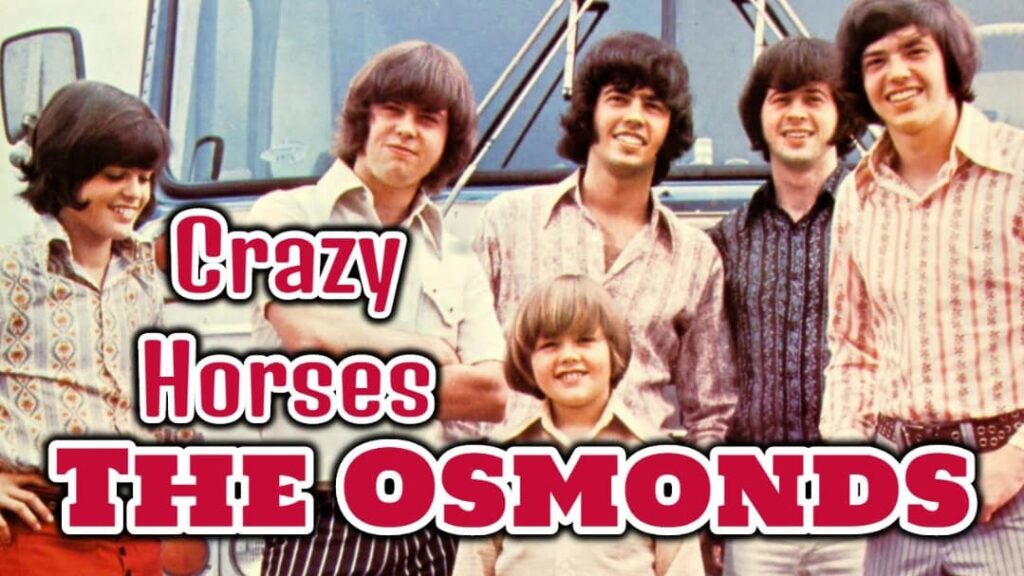
A Roaring Reflection on Environmental Reckoning: The Osmonds’ “Crazy Horses”
Ah, dear reader, cast your mind back to 1972, a year brimming with cultural shifts and musical surprises. It was a time when the seemingly wholesome, all-American Osmonds, those clean-cut, singing Mormon brothers who had captured the hearts of millions with their sugary pop harmonies and teen idol appeal, decided to unleash something entirely unexpected upon the world. They were already a sensation, having scored numerous hits like “One Bad Apple” and “Puppy Love.” But with their fourth studio album, “Crazy Horses,” and its eponymous lead single, they proved they were far more than just a boy band. This was not the Osmonds you knew; this was an Osmonds that roared, a band eager to shed their manufactured image and prove their mettle as genuine rock musicians.
Released on October 14, 1972, the single “Crazy Horses” galloped up the charts, defying expectations. It reached an impressive Number 14 on the Billboard Hot 100 in the United States and soared even higher in the UK, peaking at a remarkable Number 2 on the Official Singles Chart. This was a monumental achievement for a group often pigeonholed as a teeny-bopper phenomenon. The song, co-produced by Alan Osmond and Michael Lloyd, immediately grabbed attention with its distinct, almost jarring, opening sound—a wailing, distorted synth effect that, incredibly, was created on a Yamaha YC-30 organ with a wah-wah pedal, played by Alan Osmond, designed to mimic the neighing of a wild horse. It was a sound that would etch itself into the minds of listeners, a testament to the band’s newfound willingness to experiment and push boundaries.
The true genius and enduring legacy of “Crazy Horses” lie in its profound and prescient message. Penned by brothers Alan, Merrill, and Wayne Osmond, the song was, surprisingly, an impassioned environmental anthem. “There’s a message floatin’ in the air / Come from crazy horses riding everywhere / It’s a warnin’, it’s in every tongue / Gotta stop them crazy horses on the run,” Merrill and Jay Osmond (who took on the lead vocal duties for the verses, offering a grittier delivery than their usual saccharine style) warned. The “crazy horses smoking up the sky” were not literal steeds, but rather a powerful metaphor for the gas-guzzling automobiles that were, even then, polluting the air and threatening our planet. This was an astonishingly forward-thinking concept for a mainstream pop group in the early 1970s, long before environmentalism became a widely recognized global concern. The album cover itself reinforced this message, featuring the brothers amidst a junkyard of old, discarded cars – the very “crazy horses” that were the subject of their concern.
The story behind its creation further illuminates its significance. As Merrill Osmond himself recounted, after years of their songs being chosen for them by the record company, the brothers, emboldened by their success, yearned to create their own music, to “freak out” and explore a harder sound. The genesis of “Crazy Horses” was spontaneous, born from a basement jam session where Wayne started playing a heavy rock riff. Merrill immediately added a melody, and Alan contributed the lyrics and chords. Within an hour, the song was essentially complete. It was a stark departure from their signature sound, embracing elements of hard rock, heavy metal, and even glam rock, proving their versatility and musicianship. Jay Osmond’s growlier vocals on the verses, contrasted with Merrill’s higher-pitched chorus, perfectly suited the song’s more aggressive tone. Even Donny Osmond, whose voice was changing due to puberty, stepped back from his usual lead role, allowing the raw power of the other brothers to shine.
Perhaps one of the most amusing footnotes to the song’s history is the initial misunderstanding it caused. In some countries, notably South Africa and France, the song faced bans. Government censors, seemingly unable to fathom a clean-cut group tackling environmental issues, misinterpreted “horses” as a slang term for heroin and “smoking up the sky” as a drug reference. The irony was not lost on the Osmonds, devout Mormons who famously abstained from drugs and alcohol. This misinterpretation only further highlighted the song’s unexpected depth and unconventional nature for the time.
Today, “Crazy Horses” stands as a fascinating and often-overlooked gem in the Osmonds‘ discography. It shattered preconceived notions about the band, garnering respect from fellow musicians and proving their capabilities beyond bubblegum pop. It was a bold statement, a sign of artistic maturity, and a powerful, early warning about the environmental challenges that would only grow more pressing with each passing decade. For those of us who remember the era, it evokes a powerful sense of nostalgia, reminding us of a time when even the most unlikely artists could deliver a message that transcended their usual genre, leaving an indelible mark on the landscape of popular music. It’s a song that, even after all these years, still gallops with an undeniable, urgent energy.